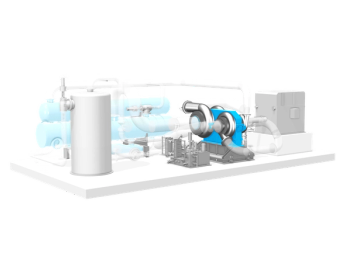
ISOTHERMAL OR INTERCOOLED COMPRESSION
THE IDEAL ISOTHERMAL COMPRESSOR HAS YET TO BE BUILT, BUT ADIABATIC COMPRESSOR STAGES ALTERNATING WITH INTERCOOLERS ARE WIDELY USED
An isothermal compressor is an old dream of the engineer, based on the value of lower specific power consumption (per unit mass) compared with regular (adiabatic) compressors. This technology could improve the efficiency of gas turbines and related plants. And it can save power in many compression jobs in process plants, especially in cases of high pressure ratio.
The ideal isothermal compressor has not yet been built, with one historic exception shown below. But approximations with adiabatic compressor stages alternating with intercoolers are widely used (Figure 1). Of course in these cases, the space requirement for the coolers is a dominant factor.
It is useful to first quantify the power savings of compression with internal cooling by means of an example: Figure 2 shows the power requirement as a function of pressure ratio for air with 15°C and 60% relative humidity. Ideal gas behavior with the specific heat being a function of temperature is assumed.
The red curve corresponds to adiabatic compression with 86% polytropic efficiency. This is the level for a good radial compressor. The green, pink and blue curves show the same for 1, 2 and 5 intercooling steps with the same polytropic efficiency in the adiabatic compression parts.
Each intercooling step requires a pressure loss, which is assumed here with 3% of the absolute pressure level. An additional assumption is that the compression after each intercooling step starts at a temperature level of 35°C (20°C above ambient). The intermediate pressure level for the intercooling steps has been chosen such that the adiabatic discharge temperatures in each compression step are all equal for the given pressure ratio.
Finally the blue dotted curve indicates the ideal limit case of isothermal compression at a temperature level of 35°C and a compression efficiency assumption of 86%.
Figure 2 indicates that one intercooling step provides more than half the power saving ideally attainable. It is also useful to look at power saving as a function of the number of intercooling steps. An example is shown in Figure 3 for a pressure ratio of 100 with the same assumptions as in Figure 2. The ideal cases of adiabatic and isothermal compression are shown as horizontal lines. The intercooled option has an optimum at 10 intercooling steps.
This demonstrates that the accumulated pressure loss in each intercooling step reduces the advantage for 11 or more intercooling steps. This optimum depends on the pressure ratio and on pressure loss assumptions. But the existence of an optimum number of intercooling steps is a general feature caused by the pressure drops in the intercoolers.
Isothermal compression
One successfully operated example of isothermal compression (Figure 4) has no rotor and no blades. D.E. Woodbridge described the system in which compression of the air is caused by falling water droplets in a vertical tunnel (The hydraulic compressed- air power plant at the Victoria Mine, The Engineering and Mining Journal Vol. LXXXIII, January 19, 1907). He claimed a measured isothermal compression efficiency of 82%.
The compression heat of the air is transmitted to the water droplets. In the case of a larger water volume excess, the two-phase flow may transform into a water flow with air bubbles. This may happen in the vertical pipe at the appropriate pressure level. In the cavity at the low end, compressed air is separated from the water and could be used in a Brayton cycle.
In Woodbridge’s approach, the pressurized water is guided back to the height corresponding to its pressure. Alternatively, it could either pass through a turbine using the remaining energy and be discharged to ambient at a lower level or it could be pumped back to the initial level. In the latter case, the system converts the water pump power into air compression.
The “exergy losses” (missed opportunities for generating useful power) of this “Rainfall compressor” are characterized by the following mechanisms: • Friction because of the relative speed (or slippage) of droplets and air or bubbles and water. This loss drops with lower droplet or bubble size
• Friction at the walls
• Friction losses at inlet (top) and outlet (bottom)
• Internal flow dissipation because of uneven velocity profile
• The (small) air portion solved in the water is not available as compressed air.
• Heat exchange across the temperature difference of air and water (may be negligible because of the typically high water-toair- mass ratio in the range of 10 to 100).
Apparently this type of rainfall compressor is not being built today. It may be because it is bulky and requires a water system which fits into the pressure requirements. But it may still be the best possible approximation of an isothermal compressor.
An interesting feature is that the mixture of water and air has the velocity of sound, which is lower than that from air or water alone (Figure 5). Astonishingly it can drop to below 30m/s, which is in the order of the falling speed.
Such systems may therefore operate locally under transonic conditions in the falling pipe, which may make the design of the channel shape difficult. This feature of two-phase mixtures is nothing new, but not generally known. Additionally, there are a few other attempts to approximate isothermal compression:
Wet compression is a known power augmentation method in gas turbines. It means spraying fine water droplets into an axial gas turbine compressor. S. Lecheler and his coauthors have given a detailed description of this commercial technology in an ASME GT paper. The known applications (sometimes called “high fogging” or “over fogging”) are limited to around 1% water flow rate (related to the air inlet mass flow rate).
Observations indicate a full evaporation of the water in the first compressor stages that forms a kind of continuous intercooling. It is an interesting thought to increase the water flow rate in order to achieve more of this continuous cooling. But this would require a water mass flow rate in the order of 50% to 100% of the air mass flow rate, even if a compressor discharge temperature in the order of 100°C is accepted. The author has not found any application in this direction.
Injector pumps driven by pressurized water are another application for compressing air. They avoid the bulky design of the rainfall compressor. The basic concept is to use a momentum driven water injector system in which a mixture of gas and liquid decelerates in a diffuser generating a pressure increase. The water-to-air ratio (by mass) could be increased to 10 or more allowing something close to isothermal compression.
But this is getting close to a conventional injector compressor. J. Keller has considered improvements to the injector shape, considering the potential transonic behavior of the two-phase mixture as mentioned above. In spite of all later attempts to improve this technology, the efficiency of such devices remains below around 40%. That means that the benefit of this nearly isothermal compression is reduced by other losses.
Therefore, it appears that the use of adiabatic compressor stages alternating with intercoolers as explained initially remains the superior methodology with respect to efficiency.
Author
Dr. Hans E. Wettstein has been working in gas turbine development from 1977 to 2011 at Baden Switzerland. The company was first Brown Boveri, then ABB and now Alstom. He started with blade and engine dynamics and continued with several leading positions including responsibilities for GT engine concepts, new gas turbine developments and development processes. For the last eight years, he has delivered a course on “Gas Turbine Mechanics and Design” for master students at ETHZ. Any questions to this article are welcome if addressed to hans.e.wettstein@bluewin.ch.
Newsletter
Power your knowledge with the latest in turbine technology, engineering advances, and energy solutions—subscribe to Turbomachinery International today.





